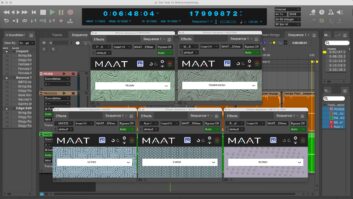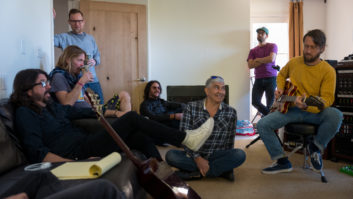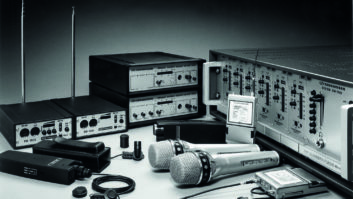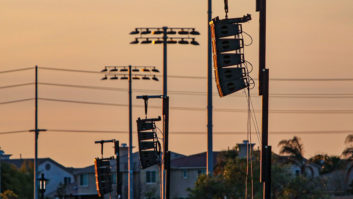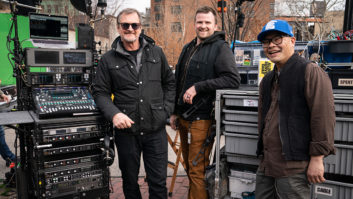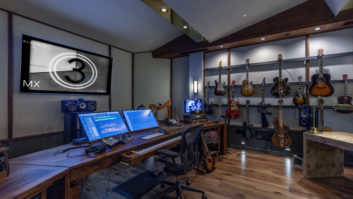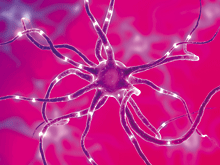
Photo: Copyright Sebastian Kaulitzki, Shutterstock
So I was washing the dishes after dinner with the TV on. The set in the kitchen is one of those little countertop jobs with rabbit ears and a 2-inch speaker. I flipped to one of the local PBS stations, and to my delight there was Jeff Beck wailing away. Suddenly, he stopped playing, and this…this child with long frizzy hair and a cherubic face was ripping off an absolutely breathtaking bass solo on an instrument almost as large as she was. I was immediately transfixed and damn near broke the plate I was rinsing. I plunked myself down in front of the diminutive tube to watch what I can only describe as a moment of unalloyed, unimpaired, unselfconscious musical joy, hardly diminished in its transmission by the fact that the audio was completely devoid of any of the bass’ fundamental frequencies and boasted at least 30 percent harmonic distortion.
If you have seen the second of Eric Clapton’s Crossroads Guitar Festivals, then you know what I’m talking about. Beck’s hour-long set was arguably the highlight of what was — inarguably — one of the best rock ‘n’ roll concerts in history. Only two of Beck’s tunes made it onto the PBS telecast and the Rhino DVD, but they are incredible, and you can find most of the rest on YouTube. After the concert, and especially after the broadcast, the blogosphere was filled with speculation as to who this young woman was. Guesses ran from Beck’s daughter to the offspring of former Grateful Dead members Keith and Donna Godchaux, but it soon came out that she is no scion of rock royalty, but merely a ferociously talented 22-year-old from Australia named Tal Wilkenfeld.
Wilkenfeld has been playing music a relatively short time. She grew up in an apparently normal middle-class family, and started playing guitar at the age of 14. Then she did something rather unusual at age 16: She dropped out of high school and moved to L.A. to study and gig. A year or so later, she took up the bass, and before long she had an endorsement deal with Sadowsky Guitars and was playing with the likes of Chick Corea, Susan Tedeschi, Vinnie Colaiuta (who was also in Beck’s band at Crossroads) and the Allman Brothers Band. She recorded her own album last year, and it features high-energy fusion and funk, plenty of complicated time signatures and a whole lot of all-star playing. The bass community has gone nuts over her, and some are hailing her as the second coming of Jaco Pastorius. I wouldn’t go that far, but she is going to be a force to be reckoned with.
But the main thing that makes it so wonderful to watch and hear her is that she is just having so much damn fun being up onstage and playing music. It’s all about the music and the myriad ways it makes her, the people she’s playing with, and the people they’re playing for, feel. She doesn’t seem to notice that she’s a young woman playing with a rock god 40 years her senior — she’s just playing. And Beck looks utterly delighted to be sharing the spotlight with her. As one longtime fan put it, “I’ve never seen him play to someone onstage with him before.” Whatever influenced Wilkenfeld to veer off the well-worn path she was expected to follow, it was the right thing to do. There’s so much happening up on that stage, on so many levels, that the performance leaves you breathless and begging for more.
Music causes us to respond in many ways, often simultaneously, and sometimes even in contradiction to each other. And it’s largely at a nonverbal level — nobody said or sang a word during Beck’s entire set. Philosophers and prophets have likened music’s power to magic — they have no other explanation for how so much can be communicated between people without words. But as the late Arthur Clarke so succinctly postulated, we consider something to be magic only if our technology isn’t sufficiently advanced to understand it. And in the case of humans’ response to music, our technology is catching up fast.
There has been a veritable explosion recently of articles and books about how music affects the brain. Books like This Is Your Brain on Music by Daniel Levitin (who delivered the keynote address at last fall’s AES convention) and neurologist Oliver Sacks’ Musicophilia have topped the best-seller lists. At the most recent International Conference on Music Perception and Cognition, more than 600 papers were presented. There are currently three-dozen university research centers on four continents devoted to the neuroscience of music and hundreds of other independent scientists working in the field.
What they are finding is no surprise to those of us who work with music every day: Its effect is profound and very, very complex. For one thing, “Music activates the same parts of the brain and causes the same neurochemical cocktail as a lot of other pleasurable activities like orgasms or eating chocolate,” writes Levitin. “Serotonin and dopamine are both involved.” This means that music is similarly addictive and may help to explain why musicians are susceptible to drug problems: They can’t be playing 24 hours a day, so they try to find something to fill the void. But that effect is important for nonabusers, too. “Most people in Western society use music to regulate moods, whether it’s playing something peppy in the morning, or something soothing at the end of a hard day, or something that will motivate them to exercise,” Levitin says.
Although scientific writings about music and the mind date back as least as far as the 1970s, a more recent technological development has boosted the quantity and quality of research: Functional Magnetic Resonance Imaging, or fMRI. Like its older sibling, plain-old MRI, fMRI takes remarkably sharp and detailed pictures of the structures inside a living organism without invasion or risk. The difference is that while the MRI is a snapshot, the fMRI shows action and in real time. Neuroscientists have gathered tons of knowledge with this tool about how human brains react to various stimuli. A favorite stimulus of researchers, because it is controllable and widely variable in its many parameters, is music.
What they’ve found is that right along with the complex models being built of the brain’s response to chemical changes, the topological model — the part of the brain that is affected when music is heard — is much more complicated than most people ever thought. fMRI research shows that music is not perceived at one specific site; instead, the response is distributed.
Jamshed Bharucha, a psychologist and violinist at Tufts University, where I teach, gave a lecture to the music department in which he showed fMRI pictures where you could clearly see distinct areas of the brain literally lighting up in response to changes in different musical parameters. You could see that the ways in which the brain responds to melody are different from the way it responds to harmony or key or tonal structure or rhythm.
Bharucha points out that the deep, nonverbal level on which music communicates indicates that it is as old, if not older, than language. For our ancestors, it was how stories were told. “We should pay more attention to music as a medium for memory and cultural knowledge,” he writes. “Prior to writing, which is very recent, [music may have provided a way] of asserting our cultural memory and passing that on through generations.”
If you’ve spent time around older people, you’ve likely seen evidence of the sub-verbal power of music among people today who have impaired brain function. An elderly relative of my wife’s has been in a nursing home for the past year. Once a highly articulate woman, she now can rarely formulate a coherent sentence. But whenever my wife goes to visit her, one of the first things she says is, “Is Paul here?” followed by, “Will he play the piano?” Even my inelegant attempts at Mozart, Bach and Cole Porter on the beat-up spinet will make her day. When she is depressed or anxious or grumpy, the staff knows to pull out a CD of her favorite Irish harp music and put the headphones on her. She doesn’t know what she is listening to, or even how for that matter, but whatever expression was on her face is quickly replaced by a peaceful smile.
Another woman — I’ll call Edith — in the nursing home hardly talks at all. If you say something to her, she’ll turn her head to look at you and say a word or two, but no more. She can’t eat by herself so she takes meals in her room, where one of the aides cuts up her food and puts it in her mouth. Last Christmas, my wife and I had dinner at the nursing home, and after dessert I sat down at the piano and banged out a few seasonal tunes. All of the talking and clanging of dishes stopped, and many people started to sing.
Astonishingly, above them all was the Edith’s voice, who had been wheeled in when her aide heard the music start. Staring intently at me so as not to miss a note, she sang all the words of all the carols and songs, sometimes even adding a harmony. If you could have watched her brain on an fMRI screen at the time, it would have looked like the sky over the Statue of Liberty on the Fourth of July. When the high note at the end of “O Holy Night” came, she soared into it and there wasn’t a dry eye in the room.
After I finished my little set, I went over to her and tapped her on the shoulder. “Merry Christmas, Edith,” I said into her ear. She turned slowly to look at me, an expression between sorrow and fear on her face, and said, “I don’t know that song.”
Music is such a precious thing, and science is only confirming what a unique and valuable medium it is. Those of us who are able to make our living in the field should be very grateful that our work can be so meaningful on so many levels. We get to play, listen, shape, mold and pass along music to others so that they can experience and be affected by it. We can’t always describe in words what it is we do and how we do it. Frank Zappa was famously quoted as saying, “Writing about music is like dancing about architecture,” but we know when it’s right. And that might happen when we hear Tal Wilkenfeld solo’ing on “‘Cause We’ve Ended As Lovers” through a 2-inch speaker or a silent old woman finding the perfect high E-flat on Christmas Day.
It would be great to see an fMRI on Wilkenfeld’s head when she’s adding her unique voice to those classic tunes with Beck, or flying with Chick Corea. Just like Edith’s, the light show would, without a doubt, be spectacular. But even more than that, I’d just like to sit down with her and jam.
When Paul Lehrman was 22, he thought he was a pretty good bass player. Now he knows better. His more recent brain flashes are documented in The Insider Audio Bathroom Reader, available at Amazon and MixBooks.

